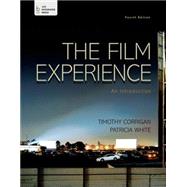In our culture, watching movies is a universal experience – but understanding film may not be. The Film Experience reaches out to students, connecting their experiences watching movies with better understanding and knowledge of the medium's full scope. And with its game-changing new video program in LaunchPad Solo (see below), this thoroughly updated new edition makes it easier than ever to link each student’s personal viewing to a greater overall understanding of film.
Timothy Corrigan and Patricia White’s classroom favorite is both authoritative and joyful about watching, analyzing, and understanding film. With clips from classic and contemporary films (Rear Window, Life of Pi, Moonrise Kingdom, Chinatown, and many others) plus hundreds of movie images and other graphics, the thoroughly revised new edition covers everything from editing to cinematography to narrative genres, all in a cultural context that reinforces why films and film study matter. The book's features—Form in Action, Film in Focus, and Concepts at Work —combine text, stills, and links to videos online to explore specific films, scenes, and trends in depth.








